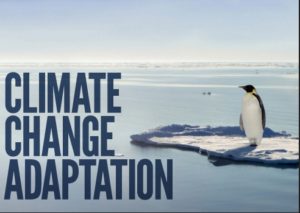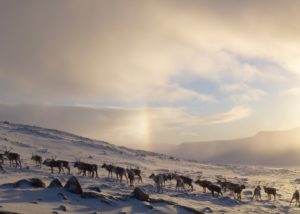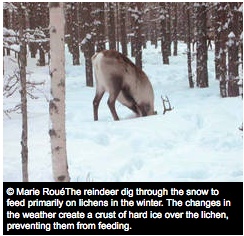The false choice of mitigation vs adaptation
It’s a dangerous dilemma for the indigenous Sami of Sweden and their reindeer
There does seem to be a growing sense, if not consensus, among the general public that climate change is for real, and is already beginning to present serious problems that will get worse over time. The extreme weather events over the past several years are a major contributor to this shift.
The challenge now is how to convince the general public, and through them the political class, that something needs to be done about climate change. Here the battle is between mitigating climate change — acting now to reduce or eliminate the greenhouse gases (GHGs) that we emit into the atmosphere — or adapting to the effects of the climate change — waiting to see what happens and then taking action. We can argue that both are necessary, but the public is fickle and lazy and want an easier answer. They look to make a choice.

Not many of those who are deeply involved with these issues are willing to say that adaptation is the easier choice, because that has the danger of undermining mitigation. Yet there is uncertainty as to the exact depth and scope and timing of impacts from climate change that will vary from local area to local area. So, it is argued, why spend money now, to mitigate, when you can wait and see more clearly what is needed before spending the effort and resources to deal with the impacts.
Of course the logic is flawed. If there is insufficient mitigation now, the warming may well exceed our ability or capacity to adapt. It will be too late. With sudden-onset tipping points, and gradual impacts, there may not be enough money to get us out of harm’s way.
The critical question is: Who is “us”? Who do we get out of harm’s way? Well, first of all, ourselves, and those we are close to or identify with — our family, friends, colleagues, fellow citizens.
On the nation level, the rich, developed countries will protect themselves, and can stay put, while the poor, developing countries will have to fend for themselves, and get out. The rich too often find it easy to dismiss the poor of other countries
When confronted with the threat that small island nations might be wiped out by sea rise, a George H. Bush administration supporter glibly suggested, “What’s wrong with a bit of sea level rise? It is merely changing land use—where there were cows there will be fish.” Those whose lives and cultures will be destroyed by even a slight rise in sea level would think otherwise. Note 1.
But even the developed, rich societies are going to have to face the reality that some parts of their own communities will, like the developing countries, need help to get out of the way.
Here’s an example. In Sweden, the indigenous Sami herders depend on the reindeer for their food, clothing and tools — the reindeer are a deep part of the Sami culture —and the reindeer depend on lichen as their primary food source. Lichen is a unique organism that takes its nutrients from the air; it also does not shed tissue.

The reindeer have been subjected to environmental threats in the past. In the 1960s, there were concerns about the radiation fallout from nuclear bomb tests on the reindeer. Then in 1986 the radioactive clouds spread from Chernobyl across Europe. Particularly hard hit by fallout from rain was northern Sweden.
In the fall of 1986, following the seasonal slaughter of the Sami reindeer, it was discovered that the carcasses contained dangerous levels of radioactive contaminants. A typical Sami family ate reindeer meat six to eight times a week, with a total average weekly intake of two pounds. Given the elevated level of contaminants, each Sami would be subjected to a dose of radiation one hundred times the recommended safe level.
The Swedish government intervened and purchased that year’s supply of reindeer meat, but this measure did not solve the long-term problem. Several generations must pass before the lichen is completely cleansed of the radioactive contaminants.
If the authorities enforced a permissible level of 300 Bq/kg of radioactive substances in reindeer meat, a substantial portion of the Sami reindeer would have had to be destroyed. Sami culture depended on the reindeer, so rather than destroy the culture by destroying the reindeer, Sweden simply raised the permissible level for cesium to 1,500 Bq/kg. Although at first blush, this solution might be seen as absurd or dangerous to the health of the Sami people, there was a precedent to the decision. The permissible level for cesium in the United States was 1,500 Bq/kg. Note 2. Thirty years later there are still elevated levels of radioactive materials found in the reindeer.
Now the Sami, and their reindeer, have to contend with climate change. Current warming and wildfires, even in the Arctic Circle, fueled in part by climate change, have destroyed grazing lands with the lichen that is critical for the reindeers’ food supply. Future climate impacts will worsen things. Warmer summers do help lichen to grow but warmer and wetter winters result in rainfall rather than snowfall in the colder months. As a result, when temperatures go below freezing, sheets of ice form instead of softer crusts of snow. The reindeer cannot smell lichen or dig through the ice so they starve to death.

Climate change represents a threat that likely will outlast even the radioactive fallout from Chernobyl.
The Sami are demanding a long-term government aid programme to help manage and adapt to the current climate change impacts on the reindeer herds. But they know that these impacts will intensify if there is insufficient mitigation and that because of climate warming the culture of an entire section of Swedish life may disappear.
The Sami are not going to go quietly. Nor should they.
Notes
Note 1. J. R. Spradley, a former prominent member of President George H. Bush’s Commerce Department, quoted in Jeremy Leggett, The Carbon War (New York: Routledge Press, 2001), 119, and quoted in Robert Emmet Hernan, “Climate Change,” This Borrowed Earth: Lessons from the 15 Worst Environmental Disasters Around the World, published in English in February 2010 by PalgraveMacmillan and in Chinese in December 2011 by China Machine Press.
Note 2. See “Chernobyl” in Robert Emmet Hernan, This Borrowed Earth (above).
Sources
Jon Henley, “Sweden’s reindeer at risk of starvation after summer drought,” The Guardian (22 August 2018). bit.ly/2w22FjK


No comments yet, add your own below